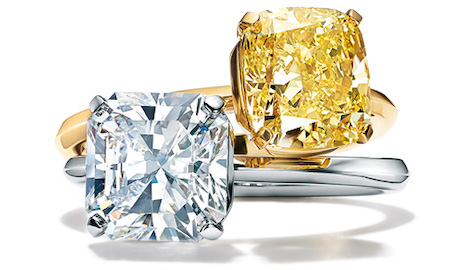 Luxury branded diamond jewelry is projected to grow. Image credit: Graff
Luxury branded diamond jewelry is projected to grow. Image credit: Graff
Despite stalling short-term growth in the diamond market, the luxury branded segment of the category is expected to grow by high single digits into 2020.
According to a report from Bain & Company and the Antwerp World Diamond Centre, geopolitical uncertainty and lower consumer confidence in the United States and China –the diamond business’ two largest markets – has led 2019 to be a “crisis year” in the industry, with declining prices and revenues for both rough and polished stones. This decline is expected to pass within the next two years and give way to long-term growth, with demand for rough diamonds expected to recover and either stay flat or grow by 3 percent annually through 2030.
"There are potentially several reasons contributing to luxury branded diamond jewelry outperforming the overall diamond market," said Olya Linde, a partner with Bain & Company and lead author of the report.
"Strong marketing efforts by luxury retailers supporting their jewelry collections; constant innovation at higher end," she said. "[There is also a] general growing affinity for luxury products among the middle class, especially in Japan and mainland China."
Demand decline
Following growth across segments of the diamond business in 2018, 2019 has been a more challenging year.
Early in 2019, there was an almost record production of rough diamonds. Coupled with a lower than expected consumer demand for polished stones, this led to a 25 percent decrease in mining revenues and a 10 percent decline in midstream revenues, including cutting and polishing.
Polished stones were impacted by softer demand, leading to a price decrease of 3 percent.
Diamond jewelry retail revenues are also down slightly, with sales expected to fall 2 percent in 2019 when measured in U.S. dollars. When measured in local currency, sales growth is projected to be flat.
U.S. retail sales are anticipated to decline by 2 percent, driven partly by a decline in Chinese tourists, while China’s diamond retail market is expected to fall 5 percent this year.
Outliers seeing growth this year are India and the Middle East.
Luxury branded diamond jewelry, which represents about 15 percent of the total diamond jewelry market, is expected to fare better, with growth in line with the personal luxury goods market.
 The Tiffany True engagement ring. Image credit: Tiffany & Co.
While only about 5 to 10 percent of diamond jewelry is purchased online, the share of ecommerce sales is rising. As sales migrate into digital channels, Bain sees the potential for pricing visibility and inventory optimization to impact the diamond retail market.
Aside from pricing transparency, companies are also being pushed to be more open about the origins of their stones.
As consumers seek out more transparency in the brands they do business with, the Diamond Producers Association looked to shed light on the positive effects of mining with a research project.
DPA tapped Trucost to conduct an independent study that looks at the socio-economic and environmental impact of diamond production, which is accessible to consumers via a dedicated Instagram account and Web site (see story).
Traceability efforts are also increasing. For instance, Tiffany & Co. has committed to telling consumers where their diamonds came from, sharing more information about the origins of its jewelry (see story).
Recovery and threats
With global markets anticipating a recession, Bain does not foresee a full recovery for the diamond business in 2020. It is therefore looking at 2021 as the year the market returns to growth.
One of the factors that could impact the long-term outlook for natural diamonds are lab-grown stones. Production of synthetic diamonds grew between 15 and 20 percent this year.
With an influx in production, particularly in India and China, lower prices and growing acceptance of the stones by retailers and jewelry brands, lab-grown disruption has ramped up.
For instance, De Beers recently launched its Lightbox brand in bricks-and-mortar retail, including Bloomingdale’s locations (see story).
The Tiffany True engagement ring. Image credit: Tiffany & Co.
While only about 5 to 10 percent of diamond jewelry is purchased online, the share of ecommerce sales is rising. As sales migrate into digital channels, Bain sees the potential for pricing visibility and inventory optimization to impact the diamond retail market.
Aside from pricing transparency, companies are also being pushed to be more open about the origins of their stones.
As consumers seek out more transparency in the brands they do business with, the Diamond Producers Association looked to shed light on the positive effects of mining with a research project.
DPA tapped Trucost to conduct an independent study that looks at the socio-economic and environmental impact of diamond production, which is accessible to consumers via a dedicated Instagram account and Web site (see story).
Traceability efforts are also increasing. For instance, Tiffany & Co. has committed to telling consumers where their diamonds came from, sharing more information about the origins of its jewelry (see story).
Recovery and threats
With global markets anticipating a recession, Bain does not foresee a full recovery for the diamond business in 2020. It is therefore looking at 2021 as the year the market returns to growth.
One of the factors that could impact the long-term outlook for natural diamonds are lab-grown stones. Production of synthetic diamonds grew between 15 and 20 percent this year.
With an influx in production, particularly in India and China, lower prices and growing acceptance of the stones by retailers and jewelry brands, lab-grown disruption has ramped up.
For instance, De Beers recently launched its Lightbox brand in bricks-and-mortar retail, including Bloomingdale’s locations (see story).
 Balmain worked with lab-grown diamond producer Diamond Foundry on earrings. Image courtesy of Diamond Foundry
"Despite a double-digit growth in production, lab-grown diamonds are still a relatively small portion of the overall diamond market," Ms. Linde said. "Over the next few years, we expect the growth in production of lab-grown diamonds to continue at current pace and retail and wholesale prices to continue to decrease.
"Significantly lower retail prices for lab-grown diamond jewelry can be an opportunity to pull younger and less affluent customers into the ‘diamond universe,' potentially creating an affinity towards diamonds that can benefit both natural and lab-grown diamond producers," she said.
Consumers are increasingly concerned about the sustainability and impact of their diamond purchases, and lab-grown producers are touting these stones as a green choice.
Balmain worked with lab-grown diamond producer Diamond Foundry on earrings. Image courtesy of Diamond Foundry
"Despite a double-digit growth in production, lab-grown diamonds are still a relatively small portion of the overall diamond market," Ms. Linde said. "Over the next few years, we expect the growth in production of lab-grown diamonds to continue at current pace and retail and wholesale prices to continue to decrease.
"Significantly lower retail prices for lab-grown diamond jewelry can be an opportunity to pull younger and less affluent customers into the ‘diamond universe,' potentially creating an affinity towards diamonds that can benefit both natural and lab-grown diamond producers," she said.
Consumers are increasingly concerned about the sustainability and impact of their diamond purchases, and lab-grown producers are touting these stones as a green choice.
Bain sees the potential for a consumer shift away from mined diamonds if there is not enough marketing promotion for natural stones.
The Diamond Producers Association, an organization that represents the largest diamond miners, has increased its marketing budget over the last few years. Just in 2019, the organization has invested between $80 and $90 million this year in advertising, accounting for about half of the total more than $200 million spent on marketing by the natural diamond business. In the latest chapter of DPA’s “Real is Rare, Real is a Diamond” campaign aimed at a millennial audience, the organization is touting the lengthy process behind natural diamonds. Launched ahead of the holiday season, “The Diamond Journey” chronicles the roles that diamonds have played throughout human history, as a sign of affection or an heirloom (see story)."There is probably no single message that will universally resonate with all types of consumers," Ms. Linde said. "Marketing will have to speak to many different types of consumers.
"Diamond Producers Association, for example, tailors the marketing messages to specific geographies," she said. "In the U.S., it is about social responsibility and positive impact of diamonds, as well as celebrating women by women. In China, it is about authenticity of love and importance of commitment.
"In India, it is about spiritual celebrations of the most important moments of a person’s life. Many of these campaigns are co-created together with the retailers already."
